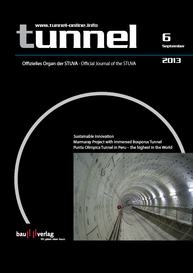“Sustainable Innovation” or “Tradition meets Modernity”
Back in the 1970s, my father always said – I can’t remember any further back: “whatever fails the test of time over 50 years isn’t included in the DIN standards”. I found this statement lacking in innovation especially as I asked myself which manufacturer of construction chemicals had existed for considerably more than 50 years. Must it take till those who developed new construction methods or products are pensioned off until they are accepted technically and normatively? Certainly not!
The innovation capacity of companies is undoubtedly one of the keys to success and especially to also assure long-term survival and growth against the background of competition that is increasing on a global basis. Particularly companies in Austria, Switzerland and Germany have established milestones in developing new standards, products and methods in tunnelling. Companies, which restrict their efforts in research and development, will eventually lose out.
When introducing innovations, companies are always faced with normative hurdles and discrepancies involving codes of practice – for instance, between European and national regulations. With regard to the subject of crack filling materials in reinforced concrete, which is the contractor’s responsibility in the majority of tunnels or foundation engineering projects, such hurdles become evident. First of all, there were the national German regulations, The ZTV-ING, Part 3, Section 5, as well as the DAfStb Guideline “Protection and Maintenance of Concrete structural Parts”. Everything is still alright here, you apply force-actuated epoxide resin, cement paste or suspension as a filler, flexibly apply polyurethane resin and hold back water using a 1-component foam, Of course, technically speaking this regulation is entirely correct, albeit for some time now force-actuated epoxide resin can be flexible and force-actuated polyurethane resin has been used to stop water. It became more complicated in 2007 when EN 1504-5 came into force. At the time a national provisional standard was created in Germany with the DIN-V-18028, forming the link between EN norm and ZTV-ING. Unfortunately, the test methodology parameters of the EN 1504-5 did not correspond with the epoxide resins and cement suspensions commonly found on the market. These obstacles were to be cleared by amending the EN 1504-5. However this resulted in the next discrepancy as acrylic gels as crack filling materials in accordance with System 2+ became available in keeping with the amended EN norm and new construction product directive. But they are not contained in the cited national German codes of practice.
Sustainability appears to me to be just as important as innovation – on the one hand for technical considerations affecting the environment and on the other in the interest of long-lasting, durable solutions. Innovation and sustainability must rank alongside one another.
What use are the latest products and methods if they also result in sustained damage to the environment. I’m thinking for instance about injection materials, which are grouted into the ground during excavation to stabilise, consolidate or prevent water: they must act neutrally against underground water as far as possible. Many must still recall the admonitory example of the Hallandsås Tunnel in Sweden. In 1997, injecting rock with acrylamide gel caused substantial ecological damage and lasting harm to people. The European manufacturer had even received a KTW permit according to the “Guideline for hygienic Assessment of organic Materials in Contact with Drinking Water” from a German institute. Fortunately nowadays there are uniform test regulations for the hygienic examination of groundwater and a permit covering groundwater hygiene (AbZ) for injecting into the ground for acrylic gels.
And now to durability. Who isn’t aware of the questions relating to 25, 50 or even 100 years durability for the offered products – something meant seriously as far as public clients engaged in building transport arteries are concerned? It goes without saying that all those involved are perfectly aware that there is actually no construction product, which has been manufactured for 50 years without being altered chemically. In other words, it is hard to obtain genuine evidence that has actually been tested. However, the manufacturer is still required within acceptable bounds to substantiate the sustainability of his products. In this connection, I am constantly amazed by companies, which come on to the market with a flood of innovations offering if anything dubious advantages both technically and regarding price. All those engaged in construction must simply realise here just how disastrously – both technically and with regard to price – such “innovations” can affect what they are building. I can only simply appeal to “commonsense”. The impossible may take place on our construction sites but not miracles. Sustainable structures, however, need sustainable and reliable products and methods, and these should be obtained from corresponding suppliers and providers with many years of experience.
I wish us all the greatest possible success in engaging with innovation and sustainability in our field of work.
Yours,
Götz Tintelnot


